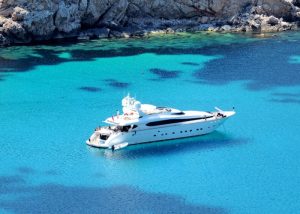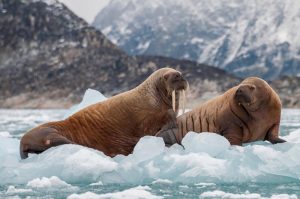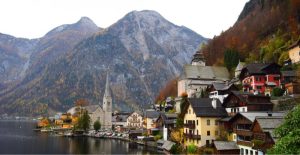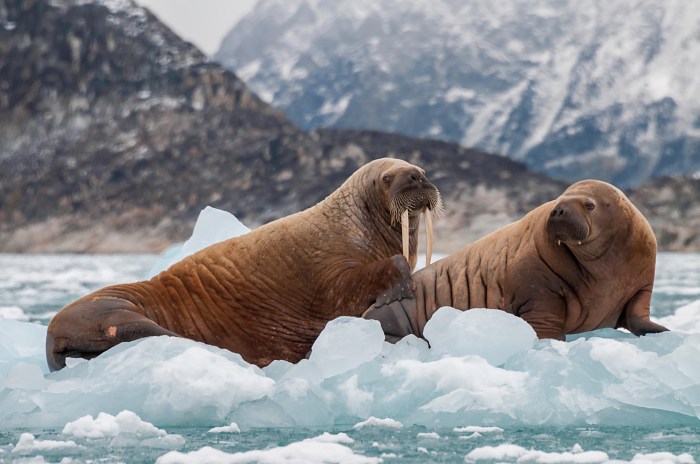
Embark on a visual journey through the icy landscapes of the Arctic as we delve into the world of Photography expeditions in the Arctic. From unique challenges to the best time for exploration, get ready to uncover the secrets of capturing the frozen beauty.
Photography Expeditions in the Arctic
Photography expeditions in the Arctic present unique challenges for photographers due to the extreme weather conditions, limited daylight hours, and remote locations.
Best Time of Year for Photography Expeditions in the Arctic
The best time for photography expeditions in the Arctic is during the summer months, specifically from June to August, when the days are long, and the sun remains above the horizon for almost 24 hours in some areas.
Equipment and Gear Necessary for Capturing Stunning Arctic Landscapes
- A sturdy and weather-sealed camera to withstand the cold temperatures and potential snow or rain.
- A variety of lenses to capture wide-angle shots of the expansive Arctic landscapes and zoom lenses for wildlife photography.
- A tripod to ensure stability in low light conditions and for long exposure shots.
- Extra batteries and memory cards as the cold weather can drain batteries quickly.
- Cold weather clothing to keep yourself warm and comfortable while spending long hours outdoors.
- A backpack to carry all your gear and essentials while exploring the Arctic terrain.
Mountain Retreats
When it comes to photography expeditions in the Arctic, choosing a mountain retreat can offer a unique and picturesque backdrop for capturing stunning images. The serene beauty of the mountains combined with the Arctic landscape creates a truly captivating setting for photographers.
Benefits of Choosing a Mountain Retreat
- Unparalleled Scenery: Mountain retreats in the Arctic provide breathtaking views of snow-capped peaks, glaciers, and pristine wilderness, offering endless opportunities for stunning photographs.
- Solitude and Serenity: Away from the hustle and bustle of cities, mountain retreats offer a peaceful and quiet environment, allowing photographers to focus on their craft without distractions.
- Unique Wildlife: Mountainous regions in the Arctic are home to a variety of wildlife species, providing photographers with the chance to capture images of animals in their natural habitat.
Comparison of Mountain Retreats in Different Arctic Regions
| Region | Key Features |
|---|---|
| Greenland | Massive glaciers, rugged peaks, and Arctic wildlife such as polar bears and whales. |
| Svalbard | Dramatic fjords, towering mountains, and the possibility of seeing the Northern Lights. |
| Alaska | Remote wilderness, diverse landscapes, and abundant wildlife including grizzly bears and bald eagles. |
Tips for Selecting the Ideal Mountain Retreat
- Research the Location: Look into the specific features and attractions of each mountain retreat to find one that aligns with your photography goals.
- Accessibility: Consider the ease of reaching the mountain retreat, as some locations may require special permits or transportation arrangements.
- Accommodation and Amenities: Check if the retreat offers comfortable lodging, facilities for photographers, and access to essential services.
- Seasonal Considerations: Take into account the best time of year to visit the mountain retreat based on weather conditions, wildlife sightings, and natural phenomena.
Wildlife Holidays
Embarking on a wildlife holiday in the Arctic presents a unique opportunity to capture stunning images of a wide range of fascinating species in their natural habitat.
Diverse Wildlife Species
During an Arctic photography expedition, you may encounter iconic Arctic wildlife such as polar bears, Arctic foxes, reindeer, walruses, seals, and various bird species including puffins and snowy owls. These majestic creatures offer photographers the chance to capture unique and captivating images that showcase the beauty of the Arctic ecosystem.
Ethical Considerations
When photographing wildlife in the Arctic, it is crucial to prioritize the well-being and safety of the animals. Respecting their natural behavior, maintaining a safe distance, and minimizing disturbances are essential ethical considerations to uphold. It is important to remember that we are guests in their environment and should strive to minimize our impact on their daily routines.
Importance of Wildlife Conservation
Photography expeditions in the Arctic also play a vital role in raising awareness about the importance of wildlife conservation. By capturing striking images of Arctic wildlife in their natural habitat, photographers can inspire others to value and protect these species and their fragile ecosystems. Conservation efforts are crucial to preserving the biodiversity of the Arctic and ensuring a sustainable future for these magnificent creatures.
Spiritual Holidays
Photography expeditions in the Arctic offer more than just stunning landscapes and wildlife encounters. They also provide a unique opportunity for photographers to connect with their spiritual side and experience moments of profound significance.
Spiritual Encounters in the Arctic
- Photographers often find themselves in awe of the vast, untouched beauty of the Arctic landscape, leading to moments of deep introspection and spiritual connection.
- The peaceful stillness of the Arctic wilderness can create a sense of calm and serenity, allowing photographers to feel more connected to nature and themselves.
- Witnessing the Northern Lights dancing across the sky or capturing the beauty of a polar bear in its natural habitat can evoke a sense of wonder and reverence for the natural world.
Festival and Events Holidays
Exploring the Arctic during photography expeditions opens up the opportunity to witness unique festivals and events that are deeply rooted in the local culture. These events can add a special dimension to your photography experience, capturing the essence of Arctic traditions and celebrations.
Unique Arctic Festivals
One of the most iconic festivals in the Arctic is the Midnight Sun Festival, where locals celebrate the endless days of sunlight during the summer solstice. This event offers stunning golden-hour photography opportunities that showcase the magical Arctic landscape bathed in the soft glow of the sun.
- Ice Music Festival: Experience the mesmerizing sounds of musical instruments made entirely of ice at this unique festival, providing a surreal backdrop for capturing extraordinary moments through your lens.
- Reindeer Racing Championships: Witness the exhilarating spectacle of reindeer racing, a traditional sport in the Arctic that offers fast-paced action shots and a glimpse into the region’s cultural heritage.
- Polar Bear Swim: Brave participants take a refreshing plunge into icy waters during this daring event, creating dramatic images of human resilience and Arctic camaraderie.
Capturing Arctic Festivals Through Photography
When photographing Arctic festivals, focus on capturing the unique cultural elements, vibrant colors, and emotional moments that define each event. Use natural light to your advantage, experiment with different angles, and be prepared to adapt to changing weather conditions to create stunning visual narratives.
Culinary and Food Tours
When embarking on an Arctic photography expedition, culinary experiences play a crucial role in enhancing the overall journey. Exploring traditional Arctic cuisine not only provides a taste of the local flavors but also offers a deeper insight into the culture and way of life in the region. Capturing food and culinary moments through photography adds another dimension to your travel memories, creating a visual feast that complements the stunning landscapes you encounter.
Traditional Arctic Cuisine and Cultural Significance
Traditional Arctic cuisine is deeply rooted in the region’s history, climate, and resources. From hearty dishes like reindeer stew and smoked fish to delicacies such as cloudberries and seal meat, each meal tells a story of survival and adaptation to the harsh Arctic environment. The use of locally sourced ingredients and age-old cooking techniques reflects the resilience and resourcefulness of the indigenous communities that call the Arctic home.
By savoring these dishes and documenting them through photography, you not only appreciate the flavors but also pay homage to the rich cultural heritage of the Arctic.
Photography Tips for Capturing Food in the Arctic
Utilize natural light
Take advantage of the soft Arctic sunlight to capture the colors and textures of your culinary subjects.
Focus on details
Zoom in on the intricate patterns of traditional utensils or the steam rising from a hot bowl of soup to add depth to your food photography.
Experiment with angles
Try shooting from different perspectives, such as overhead or at eye level, to create visually engaging images.
Incorporate the surroundings
Include elements of the Arctic landscape, like icebergs or snow-covered trees, in the background to contextualize your food photos.
Capture the process
Document the preparation of traditional Arctic dishes to showcase the craftsmanship and dedication that goes into each meal.
Vineyard and Wine Tours

Vineyard tours may seem like a world away from photography expeditions in the Arctic, but they actually share a common thread – the beauty of nature. Both experiences offer photographers the chance to capture stunning landscapes and unique environments, albeit in very different settings.
Challenges and Opportunities in Photographing Arctic Vineyards
When it comes to photographing vineyards in the Arctic, photographers face some unique challenges. The harsh Arctic climate can make it difficult to grow grapes, resulting in smaller vineyards with less vegetation compared to traditional wine regions. However, this sparse landscape also presents a distinct opportunity for photographers to capture the contrast between lush grapevines and the barren Arctic surroundings.
- Embrace the stark beauty: Use the contrast between the vineyard and Arctic landscape to create striking images.
- Focus on details: Capture the unique features of Arctic vineyards, such as snow-covered vines or ice formations.
- Play with light: Take advantage of the Arctic’s long sunsets and sunrises to capture the vineyard in different lighting conditions.
- Include local elements: Incorporate elements of Arctic culture and wildlife into your vineyard photos for added depth and context.
Golf Holidays
Combining golf holidays with photography expeditions in the Arctic can provide a unique and unforgettable experience for enthusiasts of both activities.
Scenic Golf Courses in Arctic Regions
Arctic regions boast some of the most stunning and picturesque golf courses in the world, offering not only a challenging game but also incredible photography opportunities amidst the breathtaking landscapes.
- Arctic Circle Golf Course in Rovaniemi, Finland, known as the northernmost golf course in the world, provides a unique setting with views of the Arctic wilderness.
- Lyngenfjord Golf Club in Norway offers a coastal course with stunning views of the fjords and mountains, creating a perfect backdrop for photography.
- Arctic Golf Club in Iceland features lava fields and rugged terrain, making it a visually striking location for capturing memorable moments.
Balance of Golf and Photography
While enjoying a golf holiday in the Arctic, it is essential to find a balance between playing the sport and capturing the beauty of the surroundings through photography.
- Plan your golf schedule to allow time for photography during the early mornings or late evenings when the light is ideal for capturing stunning images.
- Consider taking breaks between golf rounds to explore the surroundings and seek out unique photography spots that showcase the Arctic’s natural wonders.
- Invest in lightweight and portable photography gear that can easily accompany you on the golf course without hindering your game, ensuring you are always ready to capture the perfect shot.
Theme Park Holidays
Theme park holidays in the Arctic offer a unique and exciting experience for photography enthusiasts looking to capture unforgettable moments in a captivating setting.
Unique Arctic Theme Parks and Attractions
- Icehotel in Jukkasjärvi, Sweden: This iconic hotel made entirely of ice and snow offers stunning photo opportunities with intricate ice sculptures and unique architecture.
- Polar Park in Bardu, Norway: Home to a variety of arctic animals such as wolves, bears, and lynx, this wildlife park provides a chance to capture these majestic creatures in their natural habitat.
- Arktikum Science Museum in Rovaniemi, Finland: Explore the history and culture of the Arctic region through interactive exhibits and architectural marvels that make for interesting photo subjects.
Tips for Capturing Memorable Moments at Arctic Theme Parks
- Utilize natural light: Take advantage of the unique lighting conditions in the Arctic, such as the midnight sun or Northern Lights, to add a magical touch to your photos.
- Focus on details: Capture the intricate designs, textures, and colors found in the ice sculptures, wildlife, and architecture at Arctic theme parks to create visually stunning images.
- Experiment with perspectives: Play with angles and compositions to create dynamic and engaging photos that showcase the beauty and uniqueness of the Arctic theme parks.
Desert Adventures
Exploring the vast and contrasting landscapes of the Arctic through photography expeditions is a unique experience that offers stunning views of snow-covered terrains, icy fjords, and wildlife in their natural habitat. On the other hand, desert adventures present a completely different setting with expansive sand dunes, rocky formations, and unique flora and fauna. Let’s delve into the comparison between photography expeditions in the Arctic and desert adventures.
Unique Challenges of Photographing in the Arctic Desert Regions
Photographing in the Arctic desert regions poses several challenges that are distinct from desert environments found in warmer climates. The extreme cold temperatures, unpredictable weather conditions, and limited daylight hours in the Arctic present obstacles for capturing the essence of this unique landscape through photography. Additionally, the vast stretches of barren land and icy surfaces require careful planning and specialized gear to ensure the best possible shots.
Insights on Capturing the Contrasting Landscapes of Arctic Deserts through Photography
When photographing the contrasting landscapes of Arctic deserts, photographers have the opportunity to showcase the stark beauty of the region by capturing the interplay of light and shadows on the icy terrain. The minimalist aesthetic of the Arctic desert, with its wide open spaces and sparse vegetation, offers a unique canvas for photographers to create striking compositions. By focusing on the subtle details and textures of the landscape, photographers can convey the sense of isolation and tranquility that defines the Arctic desert regions.
Lake and River Escapes
Lake and river escapes in the Arctic offer stunning photography opportunities with their pristine beauty and unique wildlife interactions. Capturing reflections on the calm waters of Arctic lakes and rivers can result in breathtaking images that showcase the untouched wilderness of the region. Additionally, photographing wildlife along these water bodies provides a glimpse into the diverse fauna that call the Arctic home.
Techniques for Capturing Reflections
- Choose the right time of day: Early morning or late evening light can create magical reflections on the water surface.
- Use a polarizing filter: This can help reduce glare and enhance the clarity of reflections.
- Experiment with different angles: Try shooting from low perspectives to emphasize the reflections in the water.
- Utilize long exposure: Smooth out the water surface and create a mirror-like effect with longer exposure times.
Tips for Photographing Wildlife
- Be patient and observant: Wildlife sightings along lakes and rivers can be unpredictable, so take your time and watch for any movement.
- Use a telephoto lens: Get up close to wildlife without disturbing their natural behavior by using a telephoto lens.
- Focus on the eyes: Ensure the eyes of the wildlife subject are sharp and in focus for engaging and impactful photos.
- Capture natural behavior: Try to photograph wildlife in their natural habitat, showcasing their interactions with the surrounding environment.
Rural Farm Stays
Photographers on an Arctic expedition often seek out rural farm stays for a unique experience that allows them to capture the essence of local life in the Arctic region.
Rural farm stays in the Arctic offer photographers a chance to photograph a variety of unique subjects that showcase the rugged beauty and hardy lifestyle of those who call these farms home. From quaint farmhouses nestled against a backdrop of snow-capped mountains to hardworking farmers tending to their livestock in the icy wilderness, the photo opportunities are endless.
Unique Photography Subjects on Arctic Farms
- Capturing the stunning natural landscapes surrounding the farms, including vast icy fields and dramatic mountain ranges.
- Documenting the daily activities of farmers as they work in extreme conditions, showcasing their resilience and dedication.
- Focusing on the unique Arctic wildlife that can often be found near these remote farms, such as polar bears, reindeer, and arctic foxes.
- Exploring the traditional architecture of Arctic farm buildings, with their weathered wood and cozy interiors providing a glimpse into the region’s history.
Yoga and Meditation Retreats
Yoga and meditation retreats offer a unique opportunity to connect with oneself and the surrounding environment. When combined with photography expeditions in the Arctic, these practices can create a powerful and transformative experience.
Exploring the Connection
Yoga and meditation help cultivate mindfulness and presence, which are essential qualities for capturing the beauty and essence of the Arctic landscape through photography. By grounding oneself in the present moment, photographers can truly immerse themselves in the surroundings and capture the raw, untouched beauty of the Arctic.
Enhancing the Photography Experience
- Practice deep breathing exercises to calm the mind and enhance focus while capturing photos.
- Use yoga poses to improve posture and stability for steady shots in challenging Arctic conditions.
- Incorporate meditation techniques to cultivate patience and a deeper connection with the environment, resulting in more meaningful and impactful photographs.
Tips for Capturing Tranquility and Reflection
- Look for reflections in icy waters or snow-covered landscapes to add depth and serenity to your photos.
- Embrace the silence and stillness of the Arctic environment to capture moments of tranquility and peace.
- Experiment with long exposure shots to convey the sense of movement and flow in frozen landscapes.
- Aim to capture the subtle colors and textures of the Arctic landscape during golden hour for a magical and ethereal quality in your photos.
Winter Wonderland Holidays
Winter in the Arctic transforms the landscape into a mesmerizing wonderland of snow-covered mountains, icy fjords, and shimmering glaciers. The ethereal beauty of this season offers photographers a unique opportunity to capture the magical essence of the Arctic in their images.
Enchanting Winter Landscapes in the Arctic
The Arctic winter is characterized by pristine white snow blanketing the rugged terrain, creating a serene and otherworldly atmosphere. The soft light of the winter sun casts a gentle glow over the icy landscapes, enhancing the beauty of the frozen wilderness. Photographers can capture stunning scenes of snow-covered forests, frozen lakes, and majestic icebergs against the backdrop of the Arctic sky, painted in hues of pink, purple, and blue.
Challenges and Rewards of Photographing in the Arctic Winter Wonderland
Photographing in the Arctic winter presents unique challenges, such as extreme cold temperatures, limited daylight hours, and unpredictable weather conditions. However, overcoming these obstacles can lead to incredibly rewarding experiences and breathtaking images. The sense of isolation and tranquility in the Arctic winter allows photographers to connect with nature on a profound level, capturing the raw beauty and untamed wilderness of this remote region.
Techniques for Capturing the Magic of Arctic Winter Scenes
To capture the magic of Arctic winter scenes, photographers can utilize techniques such as long exposures to capture the movement of snow and ice, using a tripod to ensure sharp images in low light conditions, and experimenting with different angles and perspectives to create unique compositions. Playing with the contrast between the white snow and the dark rocks or trees can add depth and visual interest to the images.
Additionally, incorporating elements such as wildlife, human subjects, or colorful objects against the snowy backdrop can create striking visual narratives that evoke the spirit of the Arctic winter wonderland.
Arctic and Polar Holidays
Exploring the Arctic and Polar regions offers unique opportunities for photography enthusiasts to capture stunning landscapes and wildlife in their natural habitats. The extreme weather conditions, vast icy landscapes, and unique wildlife make these destinations a dream for photographers looking to capture rare and breathtaking shots.
Unique Characteristics of Arctic and Polar Holidays for Photography Expeditions
- Extreme Weather Conditions: The Arctic and Polar regions are known for their harsh weather conditions, including freezing temperatures and strong winds. Photographers need to be well-prepared with appropriate gear to protect themselves and their equipment.
- Icy Landscapes: The Arctic and Polar regions are characterized by vast icy landscapes, including glaciers, icebergs, and frozen tundras. Capturing the beauty of these frozen landscapes requires a keen eye for composition and lighting.
- Unique Wildlife: The Arctic and Polar regions are home to a diverse range of wildlife, including polar bears, seals, whales, and various bird species. Photographers have the opportunity to capture rare and stunning images of these animals in their natural habitats.
Similarities and Differences Between Arctic and Polar Photography Experiences
- Similarities:
- Both regions offer breathtaking landscapes and unique wildlife photography opportunities.
- Photographers need to be prepared for extreme weather conditions in both the Arctic and Polar regions.
- Differences:
- The Arctic region includes areas such as Alaska, Canada, and Greenland, while the Polar regions refer to the areas around the North and South Poles.
- The Arctic has more human settlements and infrastructure compared to the more remote and untouched Polar regions.
- The wildlife species found in the Arctic and Polar regions may vary, with each region having its own unique biodiversity.
Tips for Preparing for an Arctic or Polar Holiday Focused on Photography
- Invest in Quality Gear: Ensure you have high-quality cameras, lenses, and cold-weather gear to protect yourself and your equipment from the extreme conditions.
- Research Locations: Familiarize yourself with the locations you will be visiting and the wildlife you may encounter to plan your shots effectively.
- Stay Safe: Follow safety guidelines and instructions from experienced guides to ensure a safe and enjoyable photography expedition in the Arctic or Polar regions.
Music and Performing Arts Escapes
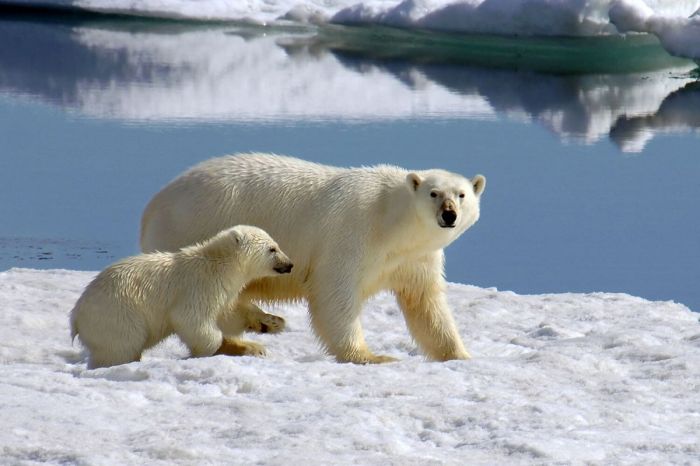
Music and performing arts play a vital role in enhancing the overall experience of photography expeditions in the Arctic. The combination of stunning natural landscapes with live music performances or artistic expressions creates a unique and unforgettable atmosphere for photographers.
Exploring Musical Performances in the Arctic
- Photographing local musicians playing traditional Inuit instruments under the Northern Lights.
- Capturing the energy of music festivals held in remote Arctic communities.
- Documenting the unique soundscapes created by the Arctic wildlife as a backdrop for artistic performances.
Artistic Expressions in the Arctic
- Photographing dancers interpreting the beauty of the Arctic landscape through movement.
- Capturing the emotional depth of theatrical performances inspired by Arctic myths and legends.
- Documenting visual artists creating pieces inspired by the colors and textures of the Arctic environment.
Educational Travel Holidays
Photography expeditions in the Arctic offer unique educational opportunities for travelers looking to enhance their knowledge while capturing stunning images of the icy landscapes. During these expeditions, participants have the chance to learn about Arctic culture, wildlife, and the environment firsthand. This immersive experience allows photographers to gain a deeper understanding of the region they are exploring, leading to more meaningful and impactful photographs.
Educational Opportunities in Arctic Photography Expeditions
- Photography workshops led by experienced professionals to improve technical skills
- Guided tours to learn about local flora, fauna, and ecosystems
- Interactions with indigenous communities to understand their way of life
- Lectures on climate change and its impact on the Arctic region
Heritage and Ancestry Trips
Exploring one’s heritage and ancestry through photography expeditions in the Arctic can be a profound and enriching experience. It allows photographers to connect with their roots, gain a deeper understanding of their cultural background, and capture the essence of their heritage in stunning images.
Significance of Heritage and Ancestry Trips in Arctic Photography
Heritage and ancestry trips in the Arctic offer photographers a unique opportunity to delve into their family history and explore the traditions and customs of their ancestors. By immersing themselves in the landscapes, people, and stories of their heritage, photographers can create powerful visual narratives that reflect their personal connection to the Arctic region.
Influencing Photographic Storytelling through Heritage Exploration
Exploring one’s heritage can deeply influence photographic storytelling by providing a rich source of inspiration and emotional depth. Photographers who have a strong connection to their heritage often bring a unique perspective and authenticity to their images, capturing the spirit and history of a place in a way that resonates with viewers on a deeper level.
Tips for Capturing Heritage and Ancestry in Arctic Photography
- Research and learn about your heritage before embarking on the trip to better understand the cultural significance of the locations you will visit.
- Engage with local communities and individuals to hear their stories and gain insights into the traditions and practices that have been passed down through generations.
- Look for visual cues and symbols that represent your heritage, such as traditional clothing, architecture, or rituals, and incorporate them into your photographs.
- Focus on capturing the emotions and connections between people and places that reflect the essence of your heritage, creating images that tell a compelling story.
- Experiment with different photography techniques and styles to convey the unique spirit and atmosphere of the Arctic region, blending modern creativity with traditional elements.
Cycling Holidays
Cycling holidays in the Arctic offer a unique opportunity to combine the thrill of adventure with the art of photography. As you pedal through stunning landscapes and rugged terrain, capturing the beauty of the Arctic becomes a thrilling challenge for any photographer.
Unique Perspectives and Challenges
- Capturing dynamic shots while cycling through Arctic landscapes requires a balance of speed and precision. Be prepared to quickly adjust your camera settings to capture fleeting moments of natural beauty.
- The constantly changing weather conditions in the Arctic present both challenges and opportunities for photography. From dramatic storm clouds to soft, diffused light, be ready to adapt to the environment to capture the best shots.
- The vast, open spaces of the Arctic provide endless possibilities for unique compositions. Experiment with different angles and perspectives to showcase the grandeur and scale of the Arctic wilderness.
Tips for Capturing Dynamic Shots
- Use a camera strap or harness to securely carry your camera while cycling, allowing you to quickly access it for spontaneous shots.
- Consider using a lightweight, versatile lens that can capture both wide-angle landscapes and close-up details without weighing you down during your cycling adventures.
- Take advantage of breaks in your cycling journey to set up tripods for stable shots, especially in low light conditions or when capturing long exposure shots of Arctic landscapes.
Synergy between Cycling Adventures and Photography
- Cycling holidays in the Arctic offer a unique perspective on the landscape, allowing photographers to explore remote locations and capture the untouched beauty of the region.
- The physical challenges of cycling through Arctic terrain can enhance your photography skills by pushing you to think creatively and adapt to changing conditions on the fly.
- By combining the thrill of cycling with the art of photography, you can create a holistic experience that immerses you in the natural wonders of the Arctic while honing your skills behind the lens.
Sailing and Yachting Breaks
Exploring the Arctic through sailing and yachting breaks offers unique photography opportunities that capture the beauty of the icy landscapes and marine wildlife in a stunning setting. The experience of photographing the Arctic from the water provides a different perspective and allows for breathtaking shots of seascapes and wildlife interactions.
Capturing Seascapes and Marine Wildlife
- Focus on the unique lighting conditions in the Arctic, including the midnight sun and the aurora borealis, to create dramatic and ethereal seascapes.
- Be prepared to capture marine wildlife such as whales, seals, and seabirds in their natural habitat, showcasing their beauty and grace in the icy waters.
- Use a telephoto lens to zoom in on distant subjects and a wide-angle lens to capture the expansive Arctic seas and skies.
- Experiment with different angles and compositions to add interest and creativity to your photos, taking advantage of the constantly changing Arctic environment.
Final Review
As we conclude our exploration of Photography expeditions in the Arctic, remember that each click of the camera lens reveals a frozen wonder waiting to be immortalized. Let your photography adventures in the Arctic continue to inspire and awe.
FAQ Corner
What are some unique challenges photographers face in the Arctic?
Photographers in the Arctic deal with extreme weather conditions, limited daylight hours, and the need for specialized gear to protect their equipment.
When is the best time of year for photography expeditions in the Arctic?
The best time for Arctic photography expeditions is usually during the winter months when the landscapes are covered in snow and the Northern Lights are visible.
What wildlife species can be captured on an Arctic photography expedition?
Arctic expeditions offer opportunities to photograph polar bears, Arctic foxes, seals, and various bird species in their natural habitat.
How can culinary experiences enhance an Arctic photography expedition?
Exploring traditional Arctic cuisine adds a cultural dimension to the photography trip, offering unique subjects to capture through the lens.
What role do vineyard tours play in photography expeditions in the Arctic?
Vineyard tours provide opportunities to capture the beauty of Arctic vineyards, showcasing a different aspect of the region through photography.
